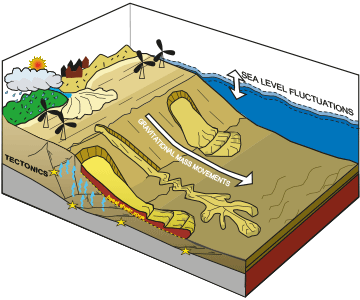Slate - Submarine Landslides and their impact on European continental margins
The over-arching aim of the European Training Network SLATE is two-fold:
- to understand key factors triggering submarine landslides, the subsequent motion and evolution of failed material, as well as ensuing geohazards, e.g. tsunamis; and
- to integrate an innovative broad range of scientific disciplines and private sector needs into a novel training-through-research and co-supervision of 15 ESRs.
SLATE focusses on investigating submarine landslides and associated geohazards as important natural risks that threaten offshore infrastructures and coastal regions in Europe. Submarine landslides can be far larger than any terrestrial landslide and can produce tsunami whose far reaching effects can rival those produced by earthquake-tsunamis, and which threaten increasingly populated European coastlines. Even small landslides can damage very expensive and critically important seafloor installations. For example, pipelines used for oil and gas recovery, or telecommunication cables that now carry over 95% of global data. The largest and most dangerous submarine landslides occur on low gradients of < 2° that are almost always stable on land. However, fundamental differences between slope failure on land and the seafloor are as yet poorly understood and remain a grand challenge.
A wide spectrum of tectonic and marine environmental settings needs to be investigated. To master this holistic approach, SLATE brings together a new team of 11 beneficiaries and 4 partner organizations from academia and non-academia from 7 European countries with an unusually comprehensive set of interdisciplinary expertise.
Only this novel multidisciplinary and inter-sectorial approach enables the SLATE ETN to to tackle the following research tasks:
- understanding pre-conditioning factors in different tectonic and sedimentary environments
- quantifying sediment-physical properties and their role for slope stability and weak layers
- identifying key controlling factors on slide kinematics and movement
- understanding the transfer of energy from submarine landslides into tsunami
- quantifying hazard from submarine landslides and derived tsunamis

